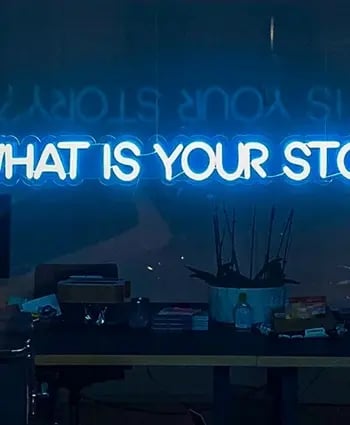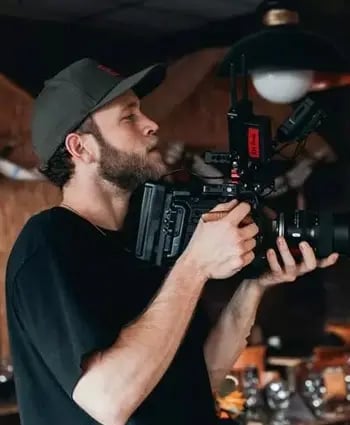How to create your video audience personas
Build out your video audience personas, then create a video activation plan that reaches them in the right places, at the right time.
Video is a powerful way to reach your ideal customers. 90% of customers agree product video aids buying decisions, and 85% want more video from brands (Forbes), but who, exactly, is your audience?
Demographics aren't enough
You might have an inkling of their demographics, sure. But remember, you need to go deeper. We saw a great LinkedIn post recently highlighting that Prince Charles and Ozzy Osborne were both born in 1948, both raised in the UK, both live in castles and are both wealthy and famous. But that doesn't mean they'd both be interested in the same things, consume the same content, or have the same challenges.
What is psychographics?
Psychographics is the fancy term for studying people's activities, interests, and opinions. Going far beyond generalising people based on demographic data, such as age, gender, or race, psychographics seek to understand what drives the behaviours of your audience.
This helps you really get into why someone might watch your video, buy a specific product/ service, support a certain cause, and much, much more.
10 Questions to ask when building out your video audience personas
- What are their challenges and frustrations?
- What motivates them?
- What types of content do they consume?
- Where do they hang out online?
- How do they make decisions?
What are their challenges and frustrations?
Business is about solving problems for your ideal customer, so you need to have good insight into what challenges them every day and what keeps them awake, staring at the ceiling at night.
When they're searching for answers to their problems, you want to be there with open arms ready to give them the solution they're seeking.
Think about what makes their lives hard and how your product or service makes things easier for them. Sometimes, that's as simple as answering frequently asked questions, and sometimes it's providing explainer videos and how-tos, so that when they're researching their issue, there you are.
What motivates them?
What drives your ideal customer to take action? What motivates them to get out of bed every day?
Let's say they want to make a difference in their business, or even change the world. Maybe they like receiving recognition for their achievements. Perhaps they want to be seen as helping others and doing what's right.
Thinking about this question can bring to mind all sorts of ideas that help you tap into the motivational drivers of your ideal audience through your video content.
What types of content do they consume?
If your audience doesn't typically watch long-form videos because they're too busy in their day-to-day lives, then a 10-minute film about why your brand is the best won't even get a glance.
If they're known to skip long ads, could you make your content snappier? Perhaps 5, 10 or even 60-second videos are more likely to keep their attention.
Their preferred tone, style and voice of video content is important to consider here, too. As well as the format of your videos. Are they more likely to engage with a simple 'how to' video or something that's a little more storytelling? Do they want something with a little more humour? Or are they more likely to want something serious?
Think about the customer journey here: awareness, consideration, and decision, and how you can use different kinds of video content to nurture them through these stages.
Where do they hang out online?
Take a step back and build a clear picture of the group you're trying to reach. Think about the channels they use, the shows they watch, and ultimately, which platforms are worth pursuing. Knowing the answer will help you figure out the best platforms to achieve your goals.
For example, you might know you want to use social media advertising to boost awareness, but your target market is under 18s. So, you're better off using TikTok or Instagram, which have more users in that demographic than Facebook. Or, if you know you want to speak to an audience that watches DIY shows, you might think about spending on pre-roll ads or Sky AdSmart.
Ultimately, to reach the right people you have to be in the right place, because if you don't think it through from the start, you risk wasting your budget, and your chances.
How do they make decisions?
How has a previous customer made decisions to buy from you and what does that process typically look like?
Think about all the roadblocks they might face along the way, the stakeholder signoffs they need to get, and the research they do before buying from you. If you can map out a classic decision-making journey, you can create content that helps them at every step.
What technology do they use?
What tech do they use in their day-to-day lives? Are they more likely to be scrolling on mobile or on their laptops? Do they watch a lot of TV? Are they big gamers?
These questions can help you to focus your efforts on creating content that's optimised for these specific technologies, as a one-size-fits-all approach won't work.
What might their objections be?
What reason have people given for not buying from you? Are there any objections that come up more frequently? Jot down any repeated words or answers.
Is budget the culprit? Or maybe it's time that they're lacking. Diving deep into these common objections can help you tailor your helpful content to appeal to your target audience.
Who are their trusted sources?
And how might you become one of those trusted sources? Are there certain industry leaders and influencers they go to for information?
Knowing who your target audience look to for guidance and info can help you tap into those sources, provide guest content, learn from them, and maybe even become a thought leader yourself.
How does your product or service fit into their lives?
What do you do to make their lives better? How does your product or service contribute to their goals?
Netflix first gained traction in the early 2000s when people were starting to get sick of late fees from places like Blockbuster (RIP). My point? They knew that there was a need for something different in their target audience's lives. And so, Netflix sent their customers DVDs by mail as part of a subscription service, allowing them to keep them for as long as they wanted.
But they didn't stop there! Had Netflix had remained a DVD-by-mail operation, it would have faded out when DVD players did. Instead, Netflix positioned itself as the easier, cheaper alternative for their customers. It's a great reminder to always have this question in mind when you're marketing to your audience.
How do they talk?
Finally, this question will help you make sure you're speaking the same language as your audience. I can't tell you the number of times I've watched video ads that are clearly targeted at me, but talk to me as if I'm a no-personality robot. Get outta here with your perfectly-formed, law-degree-level pitch, and give me that humanity; that grit, that's how you get my attention.
Are there any Facebook or LinkedIn groups your audience are a part of? Can you chat with them a little and see how they like to communicate?
This answer should include the nitty-gritty vernacular they use in their role or industry, as well as a more general elevator pitch that positions your solution in a way that resonates with them.
Strategise with Skeleton
If you know video has the potential to be a big game-changer for your business, but know you need a strategy in place that attracts, engages, and converts your ideal customers to really get the most out of it, download our Video Activation Guide, and get in touch to start plotting your next big campaign.

Written by Emily Malone Marketing Manager for Venture — a full-service video production agency that specialises in producing creative videos & campaigns that get real results.




